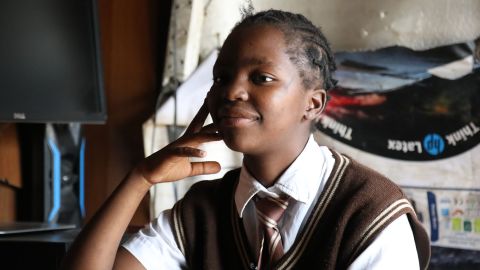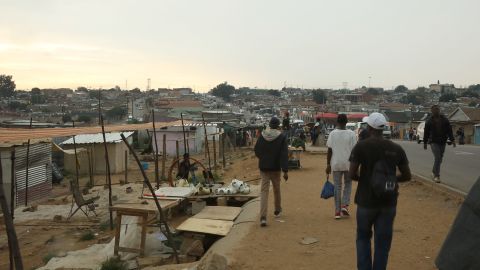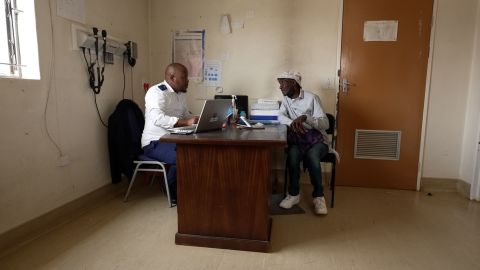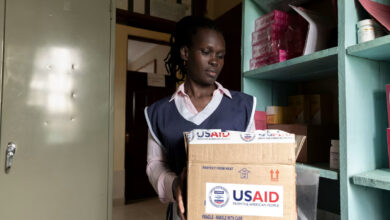
Fourteen-year-old Philasande Dayimani carries a burden that no child should carry.
Last year, she started getting sores in her mouth and struggled to breathe. She says a clinic doctor told her to test for HIV.
“It wasn’t easy for me to accept. Many people cry when they hear about their status. I also cried,” she says, seated in her small shack in Tembisa, an informal settlement north of Johannesburg, South Africa.
Dressed in a crisp brown school uniform, she retreats behind a curtain to a bedroom and brings back a canvas shopping bag with three containers of pills.
“These are the most important ones,” she tells CNN, pointing out her antiretroviral medication. Weeks after starting the pills, she felt well again.
Several years ago, Dayimani’s mother died of suspected AIDS. Now, she lives with her older brother. Doctors told her that she acquired HIV from her mother at birth.

The human immunodeficiency virus, or HIV, attacks the body’s immune system. If left untreated, it can lead to AIDS, acquired immunodeficiency syndrome. Statistics from 2021 show that about 38 million people were living with HIV infection around the world.
Twenty years ago, HIV/AIDS was a death sentence in this region. The cemeteries were full every weekend – adults cut down in their prime; children dying without access to treatment. The virus permeated every aspect of life.
Today, the HIV epidemic has faded from the headlines. It is considered by many to be a manageable condition like diabetes, thanks in no small part to an extraordinarily successful US public health initiative, that few in America may have heard of.
The roots of that success began two decades ago.
A bolt from the blue
President George W. Bush’s State of the Union address in January 2003 was dominated by Iraq, a significant moment in the lead-up to the US’s catastrophic invasion of the country.
But few could have predicted the impact of the President’s Emergency Plan for AIDS Relief (PEPFAR) that Bush announced that day.
At the time, less than 50,000 people living with HIV in sub-Saharan Africa were on treatment, despite an estimated 2.75 million people dying from AIDS globally the previous year. Antiretrovirals (ARVs) had been available in wealthy countries since the mid-1990s.
Bush’s plea during his speech seemed genuinely personal.
“Many hospitals tell people; you’ve got AIDS we can’t help you. Go home and die. In an age of miraculous medicines, no person should have to hear those words,” he said.
“I knew nothing about it. It was a complete surprise. I saw the announcement and I just felt incredible pride that PEPFAR was going to offer lifesaving treatment to those who most needed it,” John Blandford, the director of the Centers for Disease Control (CDC) in South Africa told CNN.
Blandford has been HIV-positive since the mid-1980s. He was deeply aware of the inequalities of treatment because of what he saw in the United States.
“I saw the effect in 1996. People were living with advanced AIDS and near death. They got access to these drugs, and we saw this transformation. People came back from being severely ill to thriving, gaining weight, going back to work. It was a challenge not seeing that happen in the African continent where the need was greatest,” he says.
Focused and data-driven
PEPFAR consolidated the US response and poured millions, then billions, more than 100 billion to date, into treatment and prevention. From the start, the initiative was hyper-focused and data-driven.
“It was saying ‘there is a huge problem out there, so where can we make the biggest impact?’” says Salim Abdool Karim, director of the Centre for the AIDS Program of Research in South Africa (CAPRISA) and one of South Africa’s most influential public health leaders.
Of the 15 initial PEPFAR-supported countries, South Africa was perhaps the most critical. Then and now, it carries the world’s highest HIV burden. And in the early 2000s, South Africa’s government was in a deadly state of denial.

The South African President at the time, Thabo Mbeki, resisted the rollout of antiretrovirals despite the pleas of activists, the crowded cemeteries, and the extensive evidence of the treatment’s efficacy.
The then-minister of health suggested that beetroot and garlic could have a real impact on outcomes.
“Our president was in denial and our minister of health was in denial. So, it was quite a unique problem that PEPFAR had to overcome, and it did it well,” says Karim.
He says it illustrated one of the greatest strengths of the program, to just get things done.
Karim and his team started providing ARVs at clinic in rural Kwa-Zulu Natal in 2004 and began a treatment campaign in an atmosphere of fear and stigma. Often patients were brought in on wheelbarrows, he says.
“It was quite striking, nobody said they had HIV. But it was just word of mouth and patients started streaming in. And the first thing that happened is that two or three weeks later, they would come back and tell you they were putting on weight. It was amazing to watch,” he says.
After intense international criticism and aggressive civil society protest and litigation, the government’s inaction shifted around the time that PEPFAR launched. It turned into one of the most impressive rollouts of treatment globally, with around 80 percent of the cost of treatment now borne by the South African state.
An unmitigated success story
Some countries can’t afford to take on that cost. At Motebang Hospital in Lesotho, just a few minutes drive from the South African border, patients wait on a wooden bench for their checkups.
Sixty-four-year-old Julius Molepi has been on treatment for 10 years.
“I felt weak and tired all the time and I came to the clinic to get tested. That’s how I found out,” he told CNN.

Molepi grumbles to the nurse about a lack of appetite. They chat over his medical history and viral load results. The nurse suggests that he goes on a porridge diet for a week or two.
“The people who are dying are the ones who are in denial that they are sick. If you have faith in the pills, they will work for you,” he says.
Molepi shuffles over to the dispensary window to receive his next batch of ARV treatment.
Despite being one of the world’s poorest countries, Lesotho is a success story.
In 2005, according to UNAIDS data, nearly 20,000 people in the tiny country died of HIV. That number has been reduced four-fold.
The country has reached a key milestone set out by UNAIDS: 90% of people living with HIV know their status; 90% with confirmed HIV are on treatment and 90% of those on treatment are virally suppressed.
Lesotho was part of the initial group of countries PEPFAR targeted at its inception, because of its extraordinarily high HIV prevalence rates and lack of capacity to target the virus.
Public health workers say that the aggressive rollout of testing and treatment helped change the treatment curve. It was also one of the first countries in Africa to guarantee treatment for anyone who tested positive, regardless of their viral loads.
But health workers here say it’s no time to get complacent and prevalence rates remain stubbornly high.
“We can’t put our foot off the gas. We still have people dying of AIDS. Yes, it is not as big a number as we have seen before. But we still see HIV impacting the lives of people in the household. We still see children born with HIV. We can’t forget it,” says Makhetha Moshabesha, a leader at Basotho NGO Karabo ea Bophelo.
He says the work of PEPFAR, the Global Fund, and other organizations have been instrumental in changing the course of the epidemic not just through treatment but through significant advances in prevention and behavioral change.
An epidemic at a crossroads
African and US public health officials say that the epidemic is at a significant crossroads. With more than 600,000 people dying a year of AIDS and millions going without treatment, they say there is a significant risk of backsliding.
In South Africa alone there are more than 2 million people who have HIV, but are not on treatment, despite it being free and readily available, says Blandford.
“Part of the challenge of still seeing new HIV infections is that not everybody is aware of the benefits of treatment,” he says.
One of the most significant benefits, other than individual health, is that the current generation of ARVs pushes down a person’s viral load to almost nothing, basically nullifying the risk of passing on the disease.
But for many, complacency has set in.
“The HIV epidemic is not over, not by a long shot. The scare around HIV and death is gone. And that is exactly what we wanted. We didn’t want people to think of HIV and be scared of it. But the negative is that it is no longer such a priority for people,” says Dr. Moya Mabitsi, the executive director of the ANOVA Health Institute which receives significant PEPFAR funding.
“If we don’t address that, our new infections will start coming again and the gains that we have made so far will be lost,” she says.
The impact of PEPFAR is undeniable. More than 25 million lives have been saved by the program according to the US government and it has expanded in reach and impact over the last two decades. It has also had remarkably durable bipartisan support.
Last year, US President Joe Biden appointed Dr. John Nkengasong to lead PEPFAR. The well-respected Cameroonian-born public health expert most recently helmed the Africa CDC during the Covid-19 pandemic.
Nkengasong says it is important not to lose focus in the fight against HIV – even with the recent Covid pandemic and fears over acute outbreaks like Mpox or monkeypox last year.
“Because of the remarkable success of PEPFAR and other organizations, HIV/AIDS has fallen a notch or two from the public eye. But the virus continues to be a serious health concern – and it is particularly hitting young women and girls in sub-Saharan Africa,” he says.
One reason, public health experts say, is the age and power disparity in sexual relationships: older partners, men who do not know their status, are infecting young women.
With 70% of the population of this region under 30, he says the continent is entering an especially vulnerable period.
He says PEPFAR is also looking to start shifting some of the HIV burden to governments, leading to concerns in some quarters that governments are not ready.
But Salim Abdool-Karim thinks that is a good thing.
“PEPFAR needs to go pretty soon. Probably not immediately, but soon, into a different mode. It needs to be a 10-year strategy of what you might call an exit strategy. You need to transfer these skills to local governments,” he says.
Without a cure or effective vaccine, HIV/AIDS will be a generational commitment.
Many of the children born with HIV are now entering college – living full lives – and will be able to have relationships and children with an infinitesimal risk of passing on HIV, according to the latest science. If they carefully maintain their medication.
In Tembisa, teenager Dayimani is still coming to terms with her HIV status.
“The doctors told me not to be stressed, because the virus is not actually in my blood. They are making me get rid of it,” she says. And, in practical terms, she is right.
ARVs can now achieve an undetectable viral load if the treatment regime is maintained; HIV-positive people won’t pass the virus onto their HIV-negative partners. If everyone that has HIV gets on treatment, AIDS can be beaten.
“It is just part of my life now. I can live without thinking about it,” she says.




